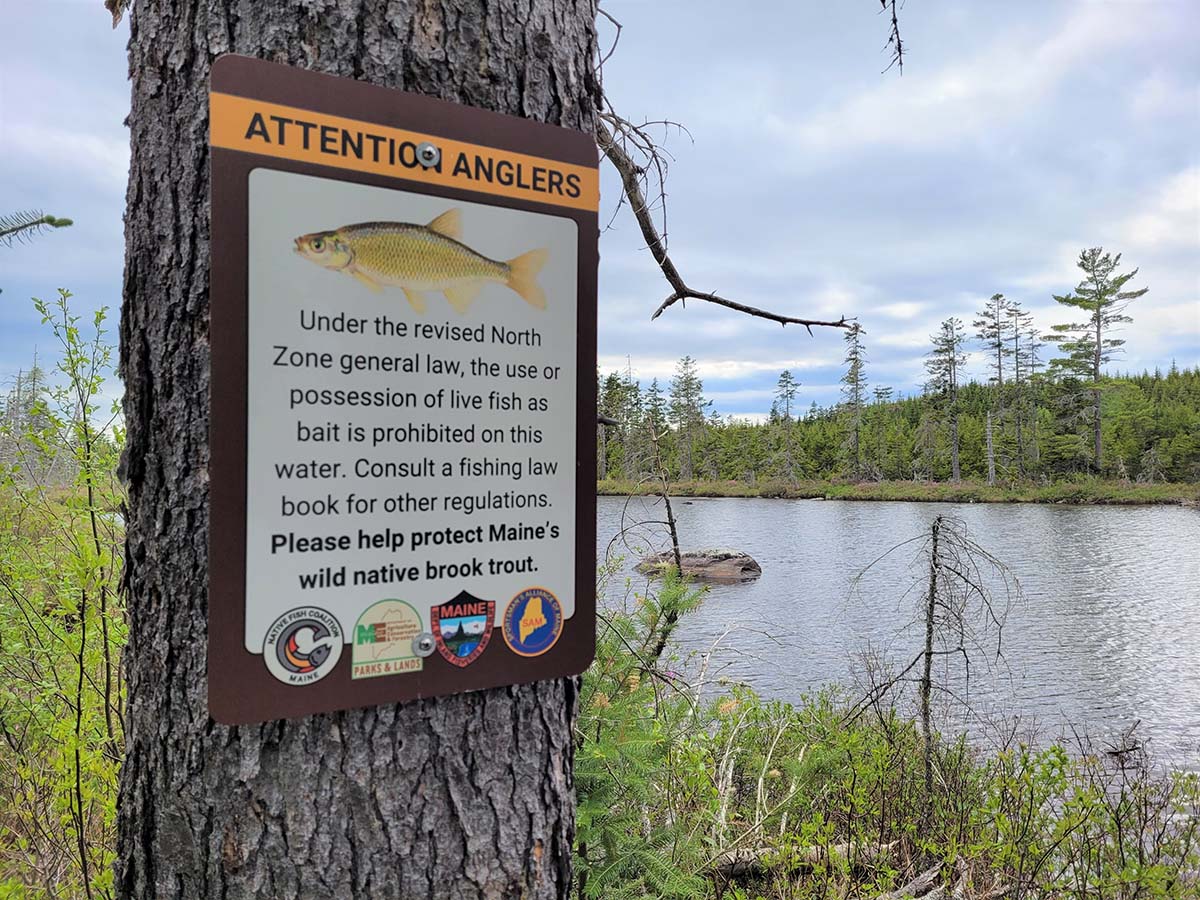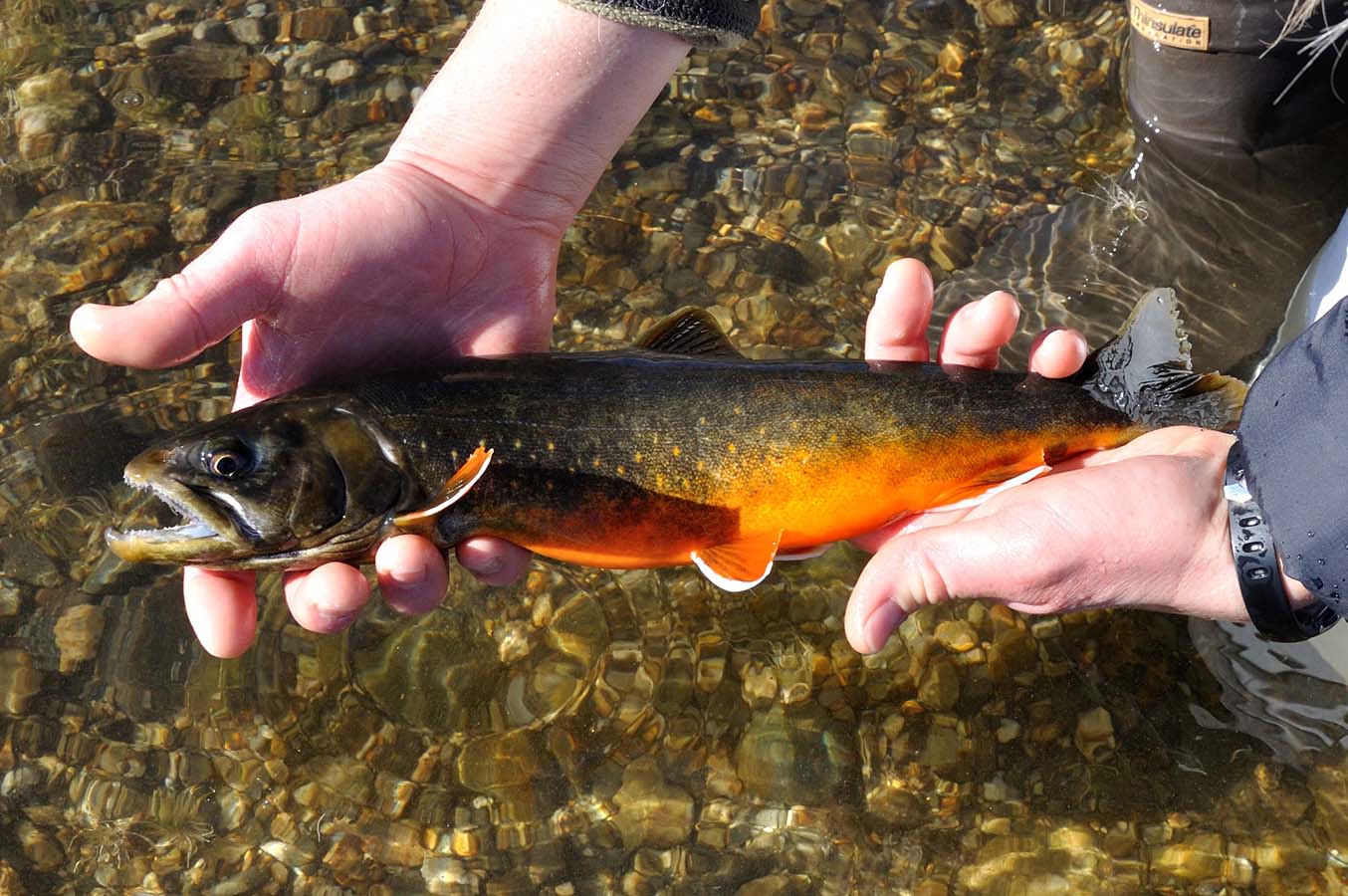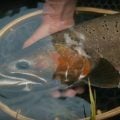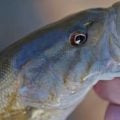A Chemophobe’s Guide to Chemical Reclamation

Once nonnative golden shiners, a popular bait species, enter small native trout ponds, trout numbers decline, hatches drop off, and everything that was dependent on them suffers. ~ Bob Mallard
Editor’s Note: This is the ninth article in our series on fly fishing conservation. This series appears with the support of Epic Fly Rods.
Native fish conservation is a challenge at best. We are trying to undo generations of misguided attempts to outthink Mother Nature while dealing with a long-standing acceptance of, and even preference for, nonnative fish due to anglers’ and fisheries managers’ perception that they are better “sport.”
Natural Balance
Aquatic ecosystems are a complex series of parts and interactions that work together to make the given watershed what it is. For every action there is a reaction, and there is no way to fully understand what that will be until you remove or add a piece. Even then it can take years to fully play out. And like a house of cards, one wrong move and the whole thing can come tumbling down.
To be clear, changes to aquatic ecosystems can affect more than just fish. They can negatively impact amphibians, birds, mammals, and even insects. Introduced trout have imperiled rare toads in the High Sierras of California, and the reduction of native cutthroat in Yellowstone Lake has deprived grizzly bears and other birds and mammals of an important food source.
Unnatural Imbalance
A trophic cascade is what happens when we reduce or remove a species from an ecosystem or introduce a nonnative species. In aquatic ecosystems this can be triggered by the removal or introduction of predatory fish or baitfish and even crustaceans and plants. It can have a top-down or bottom-up impact, and the result can be significant.
While the most documented recent example of a trophic cascade in regard to an aquatic ecosystem is Yellowstone Lake, where the introduction of nonnative lake trout have imperiled the native cutthroat, the situation at Flathead Lake in Montana (the largest natural freshwater lake in the west) was actually worse and notably more complex.
Flathead Lake was home to westslope cutthroat and bull trout. Lake trout were introduced in the early 1900s, but their numbers remained low. Kokanee salmon were introduced in the early 1920s and by the 1940s had overtaken cutthroat as the most abundant salmonid. In the early 1980s, mysis shrimp found their way into the lake from a secondary source. The kokanee population crashed, the lake trout population exploded, and the native cutthroat and rare bull trout numbers declined considerably.
When it comes to native fish population declines, nothing comes close to what we have lost to nonnative fish introductions. This includes such fabled waters as the Rapid and St. John Rivers in Maine, Ausable River in Michigan, Letort Spring Run in Pennsylvania, Batten Kill in Vermont, Beaverkill River in New York, and fabled western rivers such as the Madison, once home to native westslope cutthroat and Arctic grayling.
Unfortunately, when it comes to removing nonnative fish to save or restore native fish our options are limited. Angling and mechanical removal can help reduce nonnative populations, but they rarely eliminate them. While reductions can help, unless it’s part of an ongoing program the nonnatives rebound once the pressure is off. This leaves chemical reclamation as the only viable option.
Nothing is as controversial as chemical reclamation when it comes to native fish conservation. Attempts to use piscicides to eradicate nonnative species to restore native species are often met with opposition, including lawsuits to try to get it stopped. Misinformation spreads like wildfire, and folks resort to name-calling and other accusations with each side digging in against the other.
Opposition to chemical reclamation comes in multiple forms and from different groups. Anglers don’t want to lose their naturalized nonnative fish, conservationists see it as environmentally dangerous, and others see it as a threat to public safety. Some see chemical reclamation as a form of “ethnic cleansing,” likening it to “genocide” against wildlife. Others oppose it on religious grounds or the belief that all life is valuable. Some even see nonnative species introductions as a part of evolution and something that should be left alone. Interestingly, the latter doesn’t see chemical reclamation as an evolutionary action even though like introductions it’s humans doing it.

If not for rotenone, two of twelve remaining Arctic charr populations in the contiguous United States would have been lost. Is that a price we want to pay for refusing to use all the tools available to us? ~ Bob Mallard
Piscicides
Piscicides are chemicals used to immobilize or kill gill-breathing organisms such as fish. There is a federal process involving the EPA that dictates what you can call a “piscicide.” You can’t just throw something into the water that kills fish and call it a piscicide. The process takes things like non-target impacts and inactivation into consideration. The term ‘piscicide’ is more about the application or use than the chemical itself.
Rotenone
Rotenone is the most commonly used piscicide. It has been used for centuries by indigenous fishermen who treat the water with crushed roots containing rotenone so they can collect fish for consumption. Rotenone was first used as a piscicide in the United States in the 1930s, and while it has been used in pesticides and insecticides as well, it has been limited to piscicides in the Unites States since the early 2000s.
Rotenone is a natural organic compound, not a chemical produced in a lab. It is found in plants such as Derris elliptica from Asia, Lonchocarpus utilis from South America, and the so-called “Florida fishpoison tree,” or Piscidia piscipula found in the Florida Keys, Bahamas, and parts of Panama and Mexico.
Rotenone is classified as “non-persistent,” meaning that it does not accumulate in the water, soil, plants, or surviving animals. It breaks down quickly, and in most cases, it is all but gone in days or weeks after treatment and rendered relatively safe within just hours.
Rotenone poses little risk to humans, pets, or other lung-breathing wildlife. Per the EPA, rotenone concentrations below 40 parts per billion are safe to drink. According to Alaska Fish and Game, most treatments conducted in the state have rotenone levels well below that level.
“It is estimated that a 160-pound person would have to drink about 23,000 gallons of rotenone-treated water to receive a lethal dose.” – Alaska Fish and Game
Acknowledging Reasonable Concerns
The fact is that when we treat a water with a piscicide, fish and certain other forms of aquatic life float up to the surface dazed, dying, or dead. The chemical is an eerie green, and the folks applying the chemical are dressed in hazmat suits, and hazmat stands for “hazardous materials.” If it is so harmless, why are those doing it dressed as if they were cleaning up a nuclear waste spill?
What Is Killed by Rotenone?
Rotenone affects gill-breathing lifeforms. This includes fish and aquatic invertebrates and macroinvertebrates such as insects in their nymph, larval, and pupal stages, worms, snails, shellfish, crustaceans, and amphibians in the tadpole stage.
While rotenone affects all fish, salmonids—trout, charr and salmon—seem to be more susceptible than other families of fish. Sunfish, which includes sunfish proper as well as crappie and bass, are less sensitive. Catfish are the most resistant to rotenone, likely because unlike other fish they can breathe through their skin.
Zooplankton is as sensitive to rotenone as fish, and as the base of the food web this is important. However, after near extirpation, it is said that zooplankton populations rebuild quickly. If this were not the case, the chemical reclamation game would stop right there as the food web would be destroyed from the bottom up.
“Recent literature have reported short-term extirpation of zooplankton after rotenone application, followed by a relatively rapid recovery of zooplankton communities.” – Public Library of Science
The milky green color of piscicides is actually the result of a dye added to the mix. This is done to help those treating the water track its movement and make sure they are getting complete coverage. It also shows how quickly the chemical breaks down. As for the Ghost Buster suits, those applying rotenone are exposed to concentrations exponentially higher than what is present in the water after treatment.
What Are the Side Effects of Rotenone?
As is the case with most substances, take enough and it can have ill effects. In fact, you can actually drink enough water to kill yourself. All of the studies I looked at with regard to rotenone and birth defects and other maladies used levels far in excess of anything one would ever encounter as a result of coming into contact with water treated with a piscicide.
Even when extreme dosages of rotenone were given, most of the symptoms went away as soon as exposure was stopped. And while death can result from a large dosage, and there are reports of indigenous people dying from consuming a plant from which rotenone is derived, I could find no reputable report of a human dying from rotenone poisoning in the United States outside of what appears to have been a deliberate suicide.
Per the EPA, adults can swim in rotenone-treated water the day of application. A 1981 report said, “…swimmers should consider waiting for four hours before entering a treated pond or lake.” The agency only looked at swimming from a recreational standpoint because other recreation such as fishing would be significantly less risky.
“For all adult post-application scenarios, short-term risks for swimmers on the day
of [rotenone] application do not exceed the Agency’s level of concern.”
-EPA, Reregistration Eligibility Decision for Rotenone
What Isn’t Killed by Rotenone?
Even when the target fish species has been successfully removed non-target fish species sometimes survive reclamation, and not intentionally as we have yet to be able to develop species-specific piscicides. Some species are less susceptible to rotenone, and in other cases it may be due to how the chemical was applied. Shallow-water minnows may be too close to shore to effectively reach from a boat. In other cases, fish may burrow in silt when they sense something is wrong.
At the time of reclamation, Big Reed Pond in Maine, a rare Arctic charr water, was home to six nonnative minnow species. Only one, rainbow smelt, was considered invasive. Post chemical treatment, while it appears that the smelt were eradicated, the other five nonnative minnows — finescale dace, lake chub, white sucker, creek chub, and pearl dace – survived. In other cases, these species have been removed through chemical reclamation.
I read where even fish that have been exposed to rotenone can be revived if they are immediately placed in oxygenated untreated water, or water treated with methylene blue. This could help lessen the loss of non-target fish species if utilized accordingly.
Most mammals and birds have natural enzymes that neutralize rotenone. This means they can drink treated water or even eat fish killed by rotenone with no notable effect. One account stated that a 130-pound human would have to eat over 500 pounds of raw rotenone-treated fish to obtain a lethal dose. Another article said that cooking destroys rotenone.
How Do Lifeforms Repopulate Post-Reclamation?
When it comes to gamefish, the primary impetus behind reclamations, they are reintroduced via stocking post reclamation. As noted earlier, zooplankton recolonize on their own. Most aquatic invertebrates and macroinvertebrates are less susceptible to rotenone than fish. Enough seem to survive treatment that they are able to reestablish without intervention.
Insect populations likely receive some level of boost from Mother Nature as the wind blows adults from one body of water to another or they drift downstream from untreated waters above. And amphibians repopulate the next year due to the fact that the adults are unaffected. We could, however, do a better job of reintroducing species or giving them a boost if they survive reclamation. Like gamefish, this could be done via stocking.
Most aquatic invertebrates are returned to pre-treatment levels within several months to one year after reclamation. Fish populations take a bit longer as they have more age-classes present at any given time and it takes several years to as much as a decade or more to get there depending on the species. In most cases, however, reproduction is accelerated due to the lack of competition. This flattens out once normal abundance is attained.
In the case of amphibians, the loss is limited to primarily a percentage of the current year class. With multiple years of spawning age adults, it’s likely that things level out in a year or so. And depending on the species and timing of the reclamation, the impact on tadpoles can be minimal with those with shorter gestation periods being less affected by late-season reclamations.

Nonnative lake trout introduced to Yellowstone Lake have disrupted the entire system, including the river below as with fewer cutthroat in the lake there are by default fewer cutthroat in the river. ~ Bob Mallard
You never win people over to your cause by talking down to them, ignoring them, or worse, calling them names. But that is exactly what we are doing when it comes to responding to opposition to chemical reclamation in support of native fish restoration.
I cringe when I see the word “chemophobe” used in conjunction with opposition to chemical reclamation. The term “phobe” is short for phobia. By definition, a phobia is an “irrational fear,” or a form of “anxiety disorder.” An anxiety disorder is defined as a “mental health condition.” One medical website describes a phobia as “an irrational fear of something that’s unlikely to cause harm.”
We use terms like “loathe,” or an “intense dislike or disgust,” to describe people’s opposition to chemical restoration. This is akin to saying detest, abhor, despise, or repulsed. Opponents of chemical reclamation have been referred to as “ignorant,” “superstitious,” “saboteurs,” and poorly read.
Isn’t something that kills fish reason for concern? Might engaging folks in regard to their concerns be a better approach? While we’ll never win over everyone as the reasons for opposition are broad, we might win over some by taking the time to explain what we are trying to do and why as well as how we plan to do it and what the implications are.
I’m a chemophobe, or at least that is what some would call me. I don’t like manmade chemicals, and I don’t trust the chemical industry. I avoid prepared foods, limit the amount of chemicals in my home, don’t take medications unless absolutely necessary, and prefer hot water and natural soap to store-bought cleaning products. I don’t use synthetic fertilizers, herbicides, pesticides, or deicers. I even avoid bug sprays, opting to wear long pants and long sleeve shirts instead.
I have never gotten a flu shot, and I likely never will. I have opted not to take antibiotics after a tick bite. I don’t believe I have ever finished a prescription, opting to terminate it once the symptoms went away. And even in the face of the worst medical crisis of our time, I delayed getting a COVID shot for months, hoping it would go away on its own.
Rotenone has been used by the National Park Service to successfully restore native cutthroat and Arctic grayling in Yellowstone National Park. The NPS is best-in-class when it comes to wildlife conservation, and nowhere is that better demonstrated than YNP. It has been used to restore greenback cutthroat in Rocky Mountain National Park in Colorado, and save rare Gila trout in the southwest.
In Maine, two of the twelve remaining populations of Arctic charr in the contiguous United States were restored with rotenone. In California, golden trout would likely have been lost without rotenone. Paiute cutthroat in California have benefitted by chemical reclamation as well, and Utah has used piscicides to save Colorado River cutthroat. And this is just a partial list.
Take piscicides off the table and many native fish populations would be lost. In some cases it would mean the loss of the species. Should we give up on native ecosystems because someone did something foolish? As a self-proclaimed chemophobe, I’m willing to consider less-than-perfect alternatives. As a conservationist, I’m not willing to accept extinction until I have played all my cards.
To be fair, there are things we could do better in regard to chemical reclamation. It is a waste of resources to use lethal reclamation to prop up stocked fisheries. Ditto for naturalized nonnative fisheries, as trading one nonnative for another is not a biologically defensible position. And rather than taking a gamefish-centric position, we should consider all native species present or historically present. We could also time reclamations to lessen the impact on certain lifeforms.
In a perfect world we would not have to use piscicides to eradicate nonnative fish. But the world is not perfect, and nonnative fish pose a significant threat to native fish as well as aquatic ecosystems as a whole. Should we sit by and watch it happen or refuse to use the tools available to us to mitigate the damage because they are imperfect solutions?
As I see it, if we can fix something that we broke we should. I liken chemical reclamation in support of native fish restoration to controlling nonnative invasive snakes in the Florida Everglades to protect threatened key deer and other indigenous wildlife. How we get there is more about options, or the lack thereof, than preference.
This article appears with the support of Epic Fly Rods.











